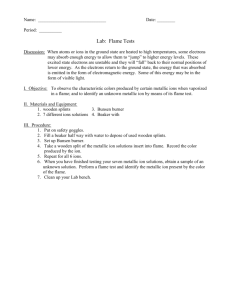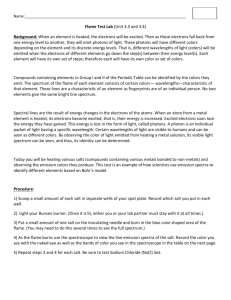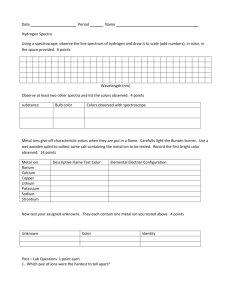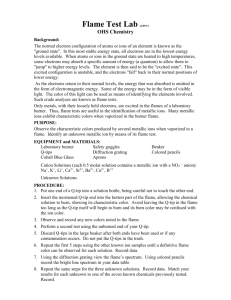Date ______________ Period _______________ Flame Test Lab
advertisement
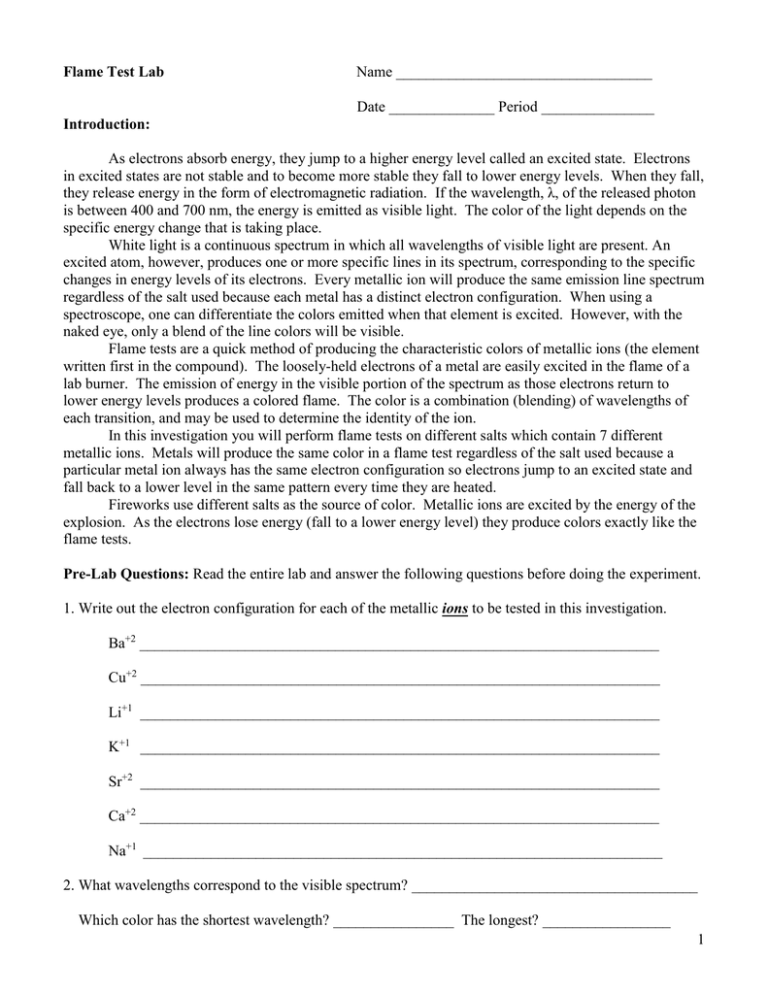
Flame Test Lab Name __________________________________ Date ______________ Period _______________ Introduction: As electrons absorb energy, they jump to a higher energy level called an excited state. Electrons in excited states are not stable and to become more stable they fall to lower energy levels. When they fall, they release energy in the form of electromagnetic radiation. If the wavelength, λ, of the released photon is between 400 and 700 nm, the energy is emitted as visible light. The color of the light depends on the specific energy change that is taking place. White light is a continuous spectrum in which all wavelengths of visible light are present. An excited atom, however, produces one or more specific lines in its spectrum, corresponding to the specific changes in energy levels of its electrons. Every metallic ion will produce the same emission line spectrum regardless of the salt used because each metal has a distinct electron configuration. When using a spectroscope, one can differentiate the colors emitted when that element is excited. However, with the naked eye, only a blend of the line colors will be visible. Flame tests are a quick method of producing the characteristic colors of metallic ions (the element written first in the compound). The loosely-held electrons of a metal are easily excited in the flame of a lab burner. The emission of energy in the visible portion of the spectrum as those electrons return to lower energy levels produces a colored flame. The color is a combination (blending) of wavelengths of each transition, and may be used to determine the identity of the ion. In this investigation you will perform flame tests on different salts which contain 7 different metallic ions. Metals will produce the same color in a flame test regardless of the salt used because a particular metal ion always has the same electron configuration so electrons jump to an excited state and fall back to a lower level in the same pattern every time they are heated. Fireworks use different salts as the source of color. Metallic ions are excited by the energy of the explosion. As the electrons lose energy (fall to a lower energy level) they produce colors exactly like the flame tests. Pre-Lab Questions: Read the entire lab and answer the following questions before doing the experiment. 1. Write out the electron configuration for each of the metallic ions to be tested in this investigation. Ba+2 _____________________________________________________________________ Cu+2 _____________________________________________________________________ Li+1 _____________________________________________________________________ K+1 _____________________________________________________________________ Sr+2 _____________________________________________________________________ Ca+2 _____________________________________________________________________ Na+1 _____________________________________________________________________ 2. What wavelengths correspond to the visible spectrum? ______________________________________ Which color has the shortest wavelength? ________________ The longest? _________________ 1 3. The metal salts will be (heated/ electrocuted) by a flame and (jump up/fall down) to a (higher/lower) energy level. Because the excited electrons are unstable, they immediately (jump up/ fall down) to a (higher/lower) energy level (releasing/absorbing) energy producing different colors. 4. Explain why a metallic ion produces a characteristic color in a flame test, regardless of the compound used as the source of the ion? ___________________________________________________________ Materials: cotton swabs unknown salt BaCl2 CuCl2 crucible tongs Ba(NO3)2 Cu(NO3)2 NaNO3 Ca(NO3)2 NaCl LiNO3 KCl CaCl2 Sr(NO3)2 KNO3 SrCl2 Procedure: 1. Put on goggles and an apron. Tie back loose hair. Put your book bags on your chair as the lab will be completed in the dark. This lab will be performed moving from station to station. Each station has a salt solution in labeled beakers, a Bunsen burner, crucible tongs and a supply of cotton swabs. One station will have an unknown salt solution. 2. Make sure the burner is lit and has a blue or almost clear flame. With your tongs, pick up the end of a swab and soak the cotton end in the solution. Hold the soaked-end of the swab in the clear part of the flame and record the flame color in the Data Table. Eventually the swab will burn giving a characteristic yellow color. Do not write yellow for each solution! Be sure you are recording the solution’s flame color. Placed the used swab in the waste beaker. 3. Possible colors: yellow, orange, yellow-green, green (blue-green), red and lilac (peach) 4. When all groups have completed their observations, the class will be instructed to clean up the lab area. Wash your hands before leaving the lab. Data Table: Salt Solution Color Salt Solution Ba(NO3)2 KNO3 BaCl2 KCl Cu(NO3)2 NaNO3 CuCl2 NaCl Sr(NO3)2 Ca(NO3)2 SrCl2 CaCl2 LiNO3 X(SO4) Color 2 Questions: 1. When electrons of metallic ions are heated they move to a ________________ energy level or a(n) ________________ state. When the electrons “fall” back to a _________________ energy level they _______________ energy in the ___________________ portion of the spectrum. 2. The colors seen when the metal salts are burned represent a _______________________ of all the lines that each ion produces when the electrons are excited and return to the ground state. 3. According to your data, determine the characteristic color produced when the following metals are excited: a. lithium ______________________ e. sodium _______________________ b. strontium ____________________ f. barium _______________________ c. calcium _____________________ g. copper _______________________ d. potassium____________________ h. unknown _____________________ 4. When a glass rod is heated, a yellow flame is observed around the point of heating. What does this mean the glass is made of? _________________Why is it observed when glass is heated? __________________________________________________________________________ 5. How do you think metallic salts are used in fireworks? __________________________________________________________________________ __________________________________________________________________________ 6. Explain why a metallic ion produces a characteristic color in a flame test, regardless of the compound used as the source of the ion. _________________________________________________________________________ _________________________________________________________________________ 7. What color did the unknown metal salt burn? _______________ 8. What metal is in the unknown compound? _________________ 9. Based on your results and observations, would this method be practical to determine metals in a mixture? Explain. __________________________________________________________________________ __________________________________________________________________________ 3
